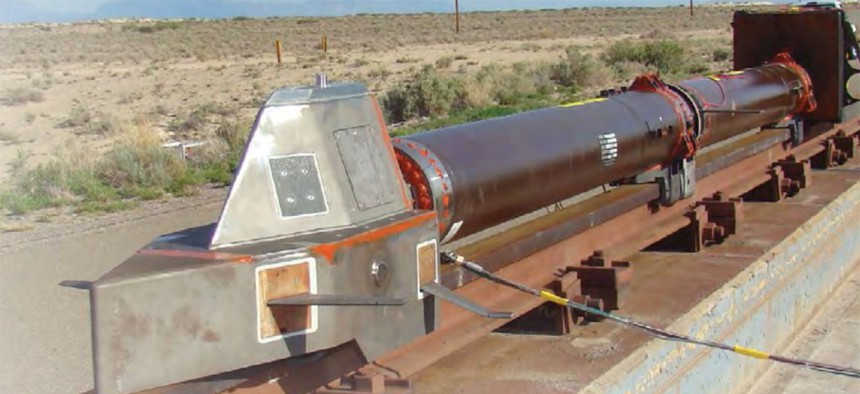
A monorail dry-run test at Holloman Air Force Base in July 2013 had no payload and used three representative carbon-epoxy panels mounted on the top and sides of the sled. Lawrence Livermore National Lab
Army Exploring ‘Devastating’ New Weapon For Use In War with Russia
The Kinetic Energy Projectile would be a tungsten warhead that moves at three times the speed of sound, destroying anything in its path.
Were the United States to go to war with Russia, both sides could draw on deadly weapons the world has never seen on a battlefield. On the Russian side, there are new and smaller tactical nuclear weapons. To counter them, the U.S. Army is taking another look at a “devastating” weapon it first tested in 2013: the Kinetic Energy Projectile, or KEP, a tungsten-based charge moving at three times the speed of sound that can destroy anything in its path.
“Think of it as a big shotgun shell,” Maj. Gen. William Hix, the Army’s director of strategy, plans and policy, said a few weeks ago at the Booz Allen Hamilton Direct Energy Summit. But unlike a shotgun shell, Hix said, the KEP moves at incredible speeds of “Mach 3 to Mach 6.”
Randy Simpson, a weapons programs manager at Lawrence Livermore National Lab, explains kinetic energy projectiles are warheads that “take advantage of high terminal speeds to deliver much more energy onto a target than the chemical explosives they carry would deliver alone.”
Said Hix: “The way that [Lawrence Livermore] have designed it is quite devastating. I would not want to be around it. Not much can survive it. If you are in a main battle tank, if you’re a crew member, you might survive but the vehicle will be non-mission capable, and everything below that will level of protection will be dead. That’s what I am talking about.”
The general emphasized the exploration was in a conceptual phase and not yet any sort of actual program: “We’re looking at ways we might — key, might — use that capability in one of our existing launch platforms as part of the weapons suite that we have," he said.
He said the main contender for a launcher would be the Army Tactical Missile System, made by Lockheed Martin.
In October 2013, an Air Force test team strapped the projectile to a “sled” on the high-speed test track at Holloman Air Force Base in New Mexico. The goal: to get it moving faster than Mach 3 and see how it might actually work in the air. The test showed the warhead design worked; it also provided data to help simulations and modeling.
Why would the U.S. military, which has put untold billions of dollars into precision weapons over several decades, need such a blunt and terrifying weapon? To counter small Russian nuclear weapons.
“The Russians … maintain their tactical nuclear stockpile in ways that we have not,” Hix said.
Potomac Institute head Philip Karber, who helped write the Pentagon’s Russia New Generation Warfare Study, offered a bit more explanation when Defense One spoke to him in January. While the United States retains just a few of its once-large arsenal of tactical nukes, Karber estimates Russia currently has anywhere from 2,000 to 5,000 of the weapons.
“Look at what the Russians have been doing in low-fission, high-fusion, sub-kiloton tactical nuclear technology,” he said. “It appears that they are putting a big effort … in both miniaturizing the warheads and using sub-kiloton low-yield warheads.”
Why is that significant? By shrinking the warhead, you can shoot it out of a wider variety of guns, including, potentially, 152-millimeter tank cannons.
“They’ve announced that the follow-on tank to the Armata will have a 152-millimeter gun missile launcher," Karber said. "They’re talking about it having a nuclear capability. And you go, ‘You’re talking about building a nuclear tank, a tank that fires a nuke?’ Well, that’s the implication."
Hix says the use of tactical battlefield nuclear weapons, even very low-level ones, is not part of official Russian military doctrine, but it is a capability they are increasingly eager to show off (and discuss) to intimidate neighbors and adversaries.
“They certainly exercise the use of those weapons in many of their exercises, including the one that participated in the parking of 30,000 to 40,000 soldiers on the Ukrainian border right before [the 2014 invasion of] Crimea," he said. "That coercive intimidation is a part of their design."
And while even Soviet generals may have shied away from using tactical nukes, Blix said, Putin’s military is “a lot more inclined philosophically to see the utility of them.”
NEXT STORY: The Steady Rise of Digital Border Searches







